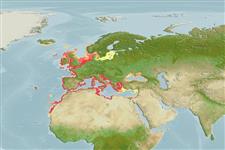Environment: milieu / climate zone / depth range / distribution range
Sinh thái học
Biển; Nước ngọt; Thuộc về nước lợ; Di cư sông biển (để đẻ trứng) (Ref. 51243); Mức độ sâu 10 - 20 m (Ref. 7399). Temperate; 64°N - 20°N, 26°W - 42°E
Eastern Atlantic: Scotland to Cape Verde; in the Mediterranean and Black Sea. Also in coastal waters from southern Norway to Morocco, rare off Mauritania (Ref. 3573). Records from the lagoon of Accra are probably misidentifications.
Length at first maturity / Bộ gần gũi / Khối lượng (Trọng lượng) / Age
Maturity: Lm 34.0 range ? - ? cm
Max length : 61.0 cm FL con đực/không giới tính; (Ref. 117745); common length : 30.0 cm SL con đực/không giới tính; (Ref. 7399); Khối lượng cực đại được công bố: 2.5 kg (Ref. 117745)
Các tia vây lưng cứng (tổng cộng): 5; Các vây lưng mềm (tổng cộng): 7-9; Tia cứng vây hậu môn 3. Longer pectoral fins, lack of black spot at the pectoral fin base. Golden spot present in gill cover (Ref. 35388).
Adults are neritic usually in schools, entering lagoons and lower estuaries (Ref. 7399); rarely entering freshwater (Ref. 3573, 59043). Juveniles move to coastal lagoons and estuaries in winter and especially in spring (Ref. 59043). They feed on small benthic organisms, detritus, and occasionally on insects and plankton (Ref. 2804). Juveniles feed only on zooplankton (Ref. 59043). Reproduction takes place in the sea, from July to November. Oviparous, eggs are pelagic and non-adhesive (Ref. 205). Minimum size allowed for fishing is 20 cm. The quality of the flesh is variable (Ref. 30578).
Juveniles move to coastal lagoons and estuaries in winter and especially in spring (Ref. 59043).
Thomson, J.M., 1986. Mugilidae. p. 344-349. In J. Daget, J.-P. Gosse and D.F.E. Thys van den Audenaerde (eds.) Check-list of the freshwater fishes of Africa (CLOFFA). ISNB, Brussels, MRAC; Tervuren; and ORSTOM, Paris. Vol. 2. (Ref. 3573)
IUCN Red List Status (Ref. 130435)
Threat to humans
Harmless
Human uses
Các nghề cá: Tính thương mại; Nuôi trồng thủy sản: Tính thương mại
Các công cụ
Special reports
Download XML
Các nguồn internet
Estimates based on models
Preferred temperature (Ref.
123201): 9.7 - 20.7, mean 11.9 °C (based on 344 cells).
Phylogenetic diversity index (Ref.
82804): PD
50 = 0.5005 [Uniqueness, from 0.5 = low to 2.0 = high].
Bayesian length-weight: a=0.01023 (0.00856 - 0.01223), b=2.95 (2.92 - 2.98), in cm total length, based on LWR estimates for this species (Ref.
93245).
Mức dinh dưỡng (Ref.
69278): 2.8 ±0.33 se; based on food items.
Generation time: 5.5 (3.7 - 6.9) years. Estimated as median ln(3)/K based on 31
growth studies.
Thích nghi nhanh (Ref.
120179): Trung bình, thời gian nhân đôi của chủng quần tối thiểu là 1.4 - 4.4 năm (K=0.14-0.34; tm=3-4; Fec>10,000).
Prior r = 0.77, 95% CL = 0.51 - 1.16, Based on 1 stock assessment.
Fishing Vulnerability (Ref.
59153): Moderate vulnerability (36 of 100).
Climate Vulnerability (Ref.
125649): Low to moderate vulnerability (35 of 100).
Nutrients (Ref.
124155): Calcium = 15.9 [5.1, 136.9] mg/100g; Iron = 0.255 [0.151, 0.421] mg/100g; Protein = 18.2 [16.9, 19.7] %; Omega3 = 1.21 [0.47, 3.11] g/100g; Selenium = 2.88 [1.17, 7.25] μg/100g; VitaminA = 12.9 [3.4, 52.7] μg/100g; Zinc = 0.478 [0.334, 0.670] mg/100g (wet weight); based on
nutrient studies.
